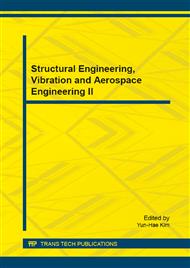p.222
p.230
p.238
p.242
p.250
p.256
p.261
p.265
p.271
The Mechanism of the Noise Transmission in the Carbody of High-Speed Trains
Abstract:
To get the noise transmission mechanism in the carbody is the precondition for noise control. In order to study the noise transmission mechanism in the carbody of the high-speed trains, the relationship of the sound pressure level (SPL) and the vibration level (VL) was analyzed base on plane sound wave, and then a special test bench in laboratory was built to evaluate the relationship. Concentrated force load and sound load wre used in the experiment. First, the “SPL-VL” formulas in every one-third octaves were found under force load. Then the sound load test was used to evaluate the formulas. The result indicates that the noise radiated by the structure bending vibration accounts for a large proportion of interior noise in the special multilayer thin-wall carbody of high-speed trains. Damping treatment is used for further instructions.
Info:
Periodical:
Pages:
250-255
Citation:
Online since:
January 2015
Authors:
Price:
Сopyright:
© 2015 Trans Tech Publications Ltd. All Rights Reserved
Share:
Citation:


